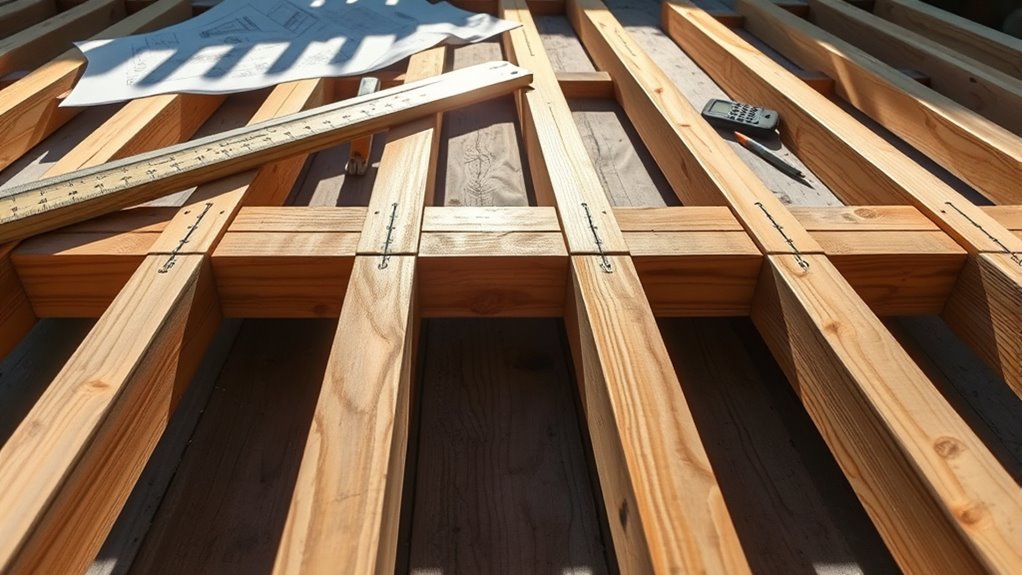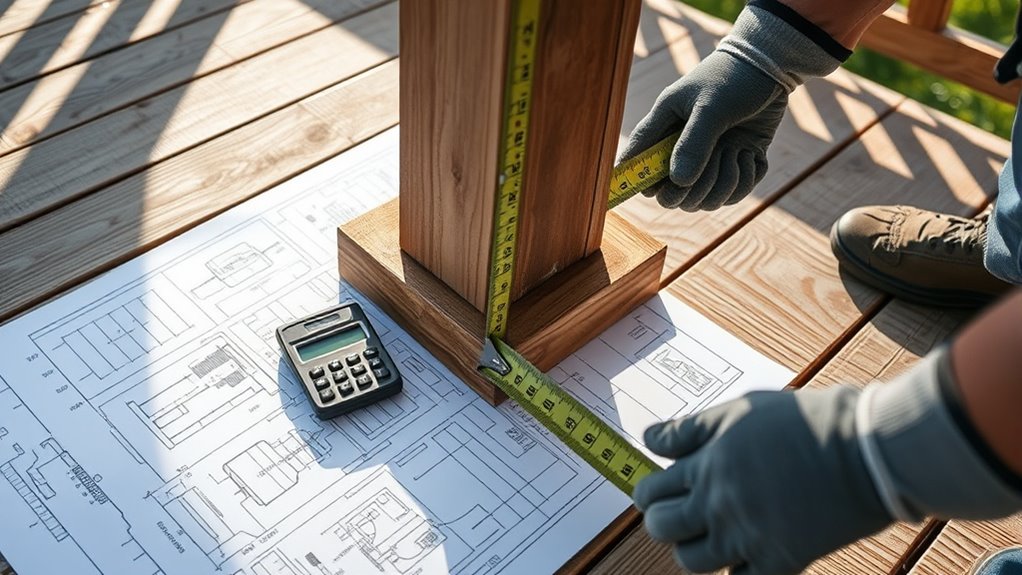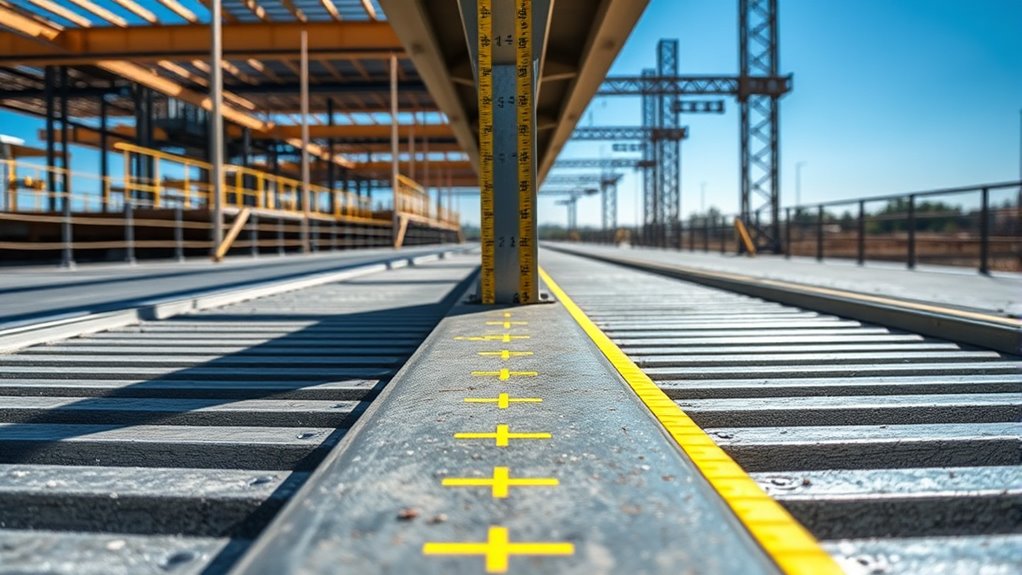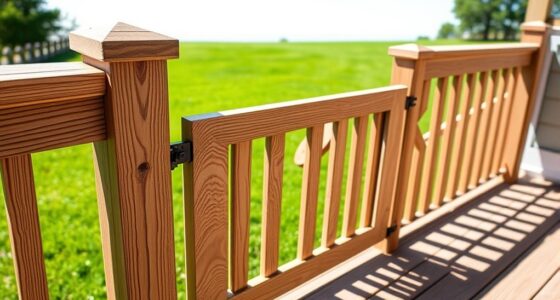To guarantee your deck is safe, you must calculate both live loads—people, furniture, and weather impacts—and dead loads like joists, beams, and decking material. Properly sizing beams and joists, and correctly placing support posts with solid foundations, help evenly distribute weight and prevent stress. Always follow local building codes and safety guidelines. Continuing will give you the detailed steps needed to confidently execute these essential calculations and build a sturdy, secure deck.
Key Takeaways
- Calculate load capacities based on deck materials, span, and support spacing to ensure safety.
- Properly position support posts considering soil conditions and load distribution.
- Use correct beam and joist sizing aligned with span length and weight requirements.
- Account for weather-related loads like snow and wind in your load calculations.
- Follow local building codes and safety standards to verify all placement and structural calculations.
Determining Live and Dead Loads for Decks

How do you accurately determine the live and dead loads for your deck? First, consider material durability—choose sturdy, weather-resistant materials that can handle weight over time. Dead loads include the weight of the deck itself, like joists, beams, decking, and railings. Aesthetic considerations also matter—select materials that match your style while maintaining strength. For safety and compliance, always refer to building code requirements and local regulations. By understanding both material durability and aesthetic preferences, you guarantee your deck can safely support daily use and future additions without compromising safety. Proper load calculation is essential to avoid structural issues down the line.
Calculating Beam and Joist Spacing and Sizing

Determining the proper spacing and sizing of beams and joists is essential for a safe and durable deck. To start, calculate the beam span, which is the distance between support posts or walls, to verify your beams can handle the load. Once you know the span, select a joist size that can support the expected weight without sagging or failure; larger joists can span longer distances with less support. Typical joist sizes range from 2×6 to 2×12, depending on span and load requirements. Proper spacing usually falls between 12 to 24 inches on center, but this depends on the joist size and the decking material. Accurate calculations will help you avoid weak points, prevent structural failure, and ensure your deck remains safe and sturdy for years to come. Considering Vetted electric bike kits can provide insights into reliable components that withstand various conditions, which is useful when planning a durable outdoor structure.
Assessing Support Post Placement and Foundation Requirements

Proper support post placement and foundation setup are essential to ensuring your deck’s stability and safety. You must carefully evaluate where posts will be placed, considering load paths and soil conditions. Use appropriate post anchoring techniques to secure supports firmly into the ground, preventing shifting or tipping. Material selection is crucial; choose durable, pressure-treated wood or steel for longevity and strength. When assessing foundation requirements, consider local building codes and environmental factors. To help visualize, here’s a quick guide:
| Support Element | Key Considerations |
|---|---|
| Post Anchoring | Secure, weather-resistant fasteners |
| Material Selection | Durability, load capacity, environmental resistance |
| Foundation Type | Concrete footings, pier blocks |
| Placement | Even spacing, aligned with load points |
Additionally, understanding the importance of structural integrity can help prevent future issues by ensuring that the foundation and support posts are properly designed to handle all anticipated loads.
Understanding Load Distribution and Stress Factors

Once your support posts are securely installed, understanding how loads are distributed across your deck becomes essential for safety and durability. The deck material plays a significant role in load distribution; heavier materials like stone or composite require more support, while lighter wood options may spread loads more evenly. Weather considerations also impact stress factors—rain, snow, and wind can add extra weight and stress to your deck. Proper load distribution ensures that weight is evenly spread across all support points, reducing the risk of structural failure. You should consider how different areas of your deck will bear weight, especially in adverse weather conditions. Additionally, load capacity varies based on the design and materials used, influencing how much weight your deck can safely support. By understanding these load and stress factors, you can better plan for safe, long-lasting deck construction that withstands environmental challenges.
Ensuring Code Compliance Through Proper Calculations

To guarantee your deck meets safety standards, it’s essential to perform accurate calculations that align with local building codes. Proper calculations ensure your structure accounts for material fatigue over time, preventing unexpected failures. Consider the load capacities of beams, joists, and posts, verifying they meet or exceed code requirements. Don’t overlook aesthetic considerations; they influence material selection and spacing, but must not compromise safety. Accurate calculations help identify potential weak points and ensure the deck’s longevity. By systematically analyzing load distribution, material strengths, and environmental factors, you stay compliant with regulations and avoid costly repairs or safety hazards. Additionally, understanding the material durability of your construction components can contribute to a more resilient design. Ultimately, precise calculations protect your investment and ensure your deck remains safe and visually appealing for years to come.
Frequently Asked Questions
What Tools Are Best for Manual Deck Load Calculations?
You should use specialized tools like load calculators, structural analysis software, and engineering tables for manual deck load calculations. These tools help you accurately assess deck safety and guarantee structural stability. By inputting specific weights and dimensions, you can determine if your deck can handle the intended loads. Always double-check your calculations and follow safety guidelines to prevent overloading and maintain deck safety and structural stability.
How Often Should Deck Load Assessments Be Updated?
You should update your deck load assessments regularly, ideally every year or whenever significant changes occur. This guarantees deck safety and maintains structural integrity, especially after modifications or damage. Frequent evaluations help identify potential issues early, preventing accidents. Stay proactive by scheduling assessments consistently, and always follow manufacturer guidelines and safety standards. Keeping assessments current safeguards your deck’s longevity and ensures it remains secure for everyone using it.
Can DIY Calculations Replace Professional Structural Analysis?
Can DIY calculations truly replace professional structural analysis? Likely not, since DIY pitfalls can compromise your deck’s structural safety. While you might handle simple assessments, complex loads and safety margins demand expert expertise. Relying solely on DIY methods risks overlooking critical factors that could lead to failure. Always consult a professional for precise, reliable evaluations to make certain your deck remains safe and sound under all conditions.
What Are Common Mistakes in Deck Load Estimations?
You often underestimate deck load, risking safety and compromising structural integrity. Common mistakes include ignoring live loads like furniture or people, oversimplifying calculations, and neglecting material strength. Always double-check your estimations, account for all potential loads, and follow proper safety guidelines. Remember, accurate deck load estimations are vital to guarantee deck safety and maintain the structural integrity of your construction. Never cut corners—professional assessment is highly recommended for critical loads.
How Do Environmental Factors Influence Load Calculations?
Environmental factors like wind impact and moisture effects considerably influence load calculations. Wind can add lateral forces that increase the overall load your deck must support, so you need to account for gusts and prevailing wind conditions. Moisture effects, such as rain or humidity, can weaken materials over time, reducing load capacity. Always factor in these environmental elements to guarantee your deck’s load calculations are accurate and safe under real-world conditions.
Conclusion
By paying close attention to these calculations, you’re gently guiding your deck’s foundation toward a sturdy, reliable future. Think of each careful measurement as planting a strong root, allowing your outdoor space to flourish safely. When you respect these principles, your deck becomes a welcoming haven, secure and enduring—like a sturdy bridge connecting you to unforgettable moments. Embrace the process, and watch your vision come to life with confidence and grace.









